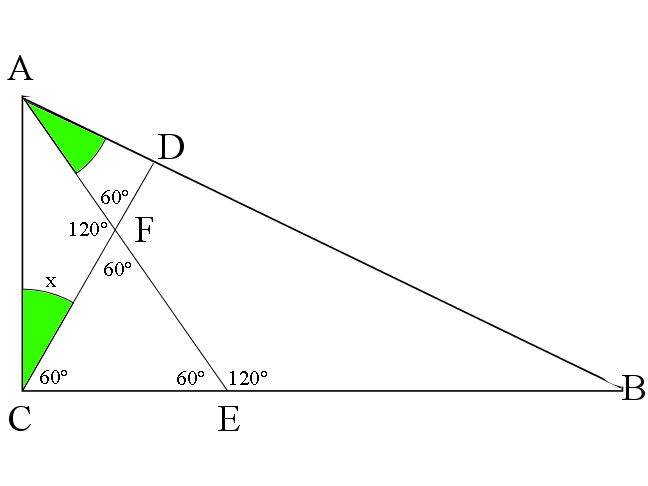Difference between revisions of "2010 AMC 12A Problems/Problem 8"
(→Solution 3 (Similar Triangles)) |
(→Solution 2(Trig and Angle Chasing)) |
||
| Line 19: | Line 19: | ||
== Solution 2(Trig and Angle Chasing) == | == Solution 2(Trig and Angle Chasing) == | ||
| − | Let < | + | Let <cmath>AB=2a, AC=a</cmath> |
| + | Let <cmath>\angle BAE=\angle ACD=x</cmath> | ||
| + | Because <math>\triangle CFE</math> is equilateral, we get <math>\angle FCE=60</math>, so <math>\angle ACB=60+x</math> | ||
| − | By | + | Because <math>\triangle CFE</math> is equilateral, we get <math>\angle CFE=60</math>. |
| + | |||
| + | Angles <math>AFD</math> and <math>CFE</math> are vertical, so <math>\angle AFD=60</math>. | ||
| + | |||
| + | By triangle <math>ADF</math>, we have <math>\angle ADF=120-x</math>, and because of line <math>AB</math>, we have <math>\angle BDC=60+x</math>. | ||
| + | |||
| + | Because Of line <math>BC</math>, we have <math>\angle AEB=120</math>, and by line <math>CD</math>, we have <math>\angle DFE=120</math>. | ||
| + | |||
| + | By quadrilateral <math>BDFE</math>, we have <math>\angle ABC=60-x</math>. | ||
| + | |||
| + | By the Law of Sines: | ||
| + | <cmath>\frac{\sin(60-x)}{a}=\frac{\sin(60+x)}{2a}\implies \sin(60-x)=\frac{\sin(60+x)}{2}\implies 2\sin(60-x)=\sin(60+x)</cmath> | ||
| + | |||
| + | By the sine addition formula(<math>\sin(a+b)=\sin(a)\cos(b)+\cos(a)\sin(b)</math>): | ||
| + | <cmath>2(\sin(60)\cos(-x)+\cos(60)\sin(-x))=\sin(60)\cos(x)+\cos(60)\sin(x)</cmath> | ||
| + | |||
| + | Because cosine is an even function, and sine is an odd function, we have <cmath>2\sin(60)\cos(x)-2\cos(60)\sin(x)=\sin(60)\cos(x)+\cos(60)\sin(x) \implies \sin(60)\cos(x)=3\cos(60)\sin(x)</cmath> | ||
| + | |||
| + | We know that <math>\sin(60)=\frac{\sqrt{3}}{2}</math>, and <math>\cos(60)=\frac{1}{2}</math>, hence | ||
| + | <cmath>\frac{\sqrt{3}}{2}\cos(x)=\frac{3}{2}\sin(x)\implies \tan(x)=\frac{\sqrt{3}}{3}</cmath> | ||
| + | |||
| + | The only value of <math>x</math> that satisfies <math>60+x<180</math>(because <math>60+x</math> is an angle of the triangle) is <math>x=30^{\circ}</math>. We seek to find <math>\angle ACB</math>, which as we found before is <math>60+x</math>, which is <math>90</math>. The answer is <math>90, \text{or} \textbf{(C)}</math> | ||
-vsamc | -vsamc | ||
Revision as of 02:42, 17 January 2022
Contents
Problem
Triangle ![]() has
has ![]() . Let
. Let ![]() and
and ![]() be on
be on ![]() and
and ![]() , respectively, such that
, respectively, such that ![]() . Let
. Let ![]() be the intersection of segments
be the intersection of segments ![]() and
and ![]() , and suppose that
, and suppose that ![]() is equilateral. What is
is equilateral. What is ![]() ?
?
![]()
Solution 1

Let ![]() .
.

Since ![]() and the angle between the hypotenuse and the shorter side is
and the angle between the hypotenuse and the shorter side is ![]() , triangle
, triangle ![]() is a
is a ![]() triangle, so
triangle, so ![]() .
.
Solution 2(Trig and Angle Chasing)
Let ![]() Let
Let ![]() Because
Because ![]() is equilateral, we get
is equilateral, we get ![]() , so
, so ![]()
Because ![]() is equilateral, we get
is equilateral, we get ![]() .
.
Angles ![]() and
and ![]() are vertical, so
are vertical, so ![]() .
.
By triangle ![]() , we have
, we have ![]() , and because of line
, and because of line ![]() , we have
, we have ![]() .
.
Because Of line ![]() , we have
, we have ![]() , and by line
, and by line ![]() , we have
, we have ![]() .
.
By quadrilateral ![]() , we have
, we have ![]() .
.
By the Law of Sines:
![]()
By the sine addition formula(![]() ):
):
![]()
Because cosine is an even function, and sine is an odd function, we have ![]()
We know that ![]() , and
, and ![]() , hence
, hence
![]()
The only value of ![]() that satisfies
that satisfies ![]() (because
(because ![]() is an angle of the triangle) is
is an angle of the triangle) is ![]() . We seek to find
. We seek to find ![]() , which as we found before is
, which as we found before is ![]() , which is
, which is ![]() . The answer is
. The answer is ![]()
-vsamc
Solution 3 (Similar Triangles)
Notice that ![]() and
and ![]() . Hence, triangle AEB is similar to triangle CFA. Since
. Hence, triangle AEB is similar to triangle CFA. Since ![]() ,
, ![]() , as triangle CFE is equilateral. Therefore,
, as triangle CFE is equilateral. Therefore, ![]() , and since
, and since ![]() ,
, ![]() . Thus, the measure of
. Thus, the measure of ![]() equals to
equals to ![]() -HarryW
-HarryW
Video Solution by the Beauty of Math
https://youtu.be/kU70k1-ONgM?t=785
See also
| 2010 AMC 10A (Problems • Answer Key • Resources) | ||
| Preceded by Problem 13 |
Followed by Problem 15 | |
| 1 • 2 • 3 • 4 • 5 • 6 • 7 • 8 • 9 • 10 • 11 • 12 • 13 • 14 • 15 • 16 • 17 • 18 • 19 • 20 • 21 • 22 • 23 • 24 • 25 | ||
| All AMC 10 Problems and Solutions | ||
| 2010 AMC 12A (Problems • Answer Key • Resources) | |
| Preceded by Problem 7 |
Followed by Problem 9 |
| 1 • 2 • 3 • 4 • 5 • 6 • 7 • 8 • 9 • 10 • 11 • 12 • 13 • 14 • 15 • 16 • 17 • 18 • 19 • 20 • 21 • 22 • 23 • 24 • 25 | |
| All AMC 12 Problems and Solutions | |
The problems on this page are copyrighted by the Mathematical Association of America's American Mathematics Competitions. 









